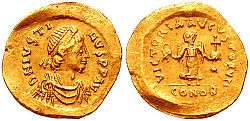Excubitors
The Excubitors (Latin: excubitores or excubiti, literally "those out of bed", i.e. "sentinels"; transcribed into Greek as ἐξκουβίτορες or ἐξκούβιτοι) were founded in c. 460 as the imperial guards of the early Byzantine emperors. Their commanders soon acquired great influence and provided a series of emperors in the 6th century. The Excubitors fade from the record in the late 7th century, but in the mid-8th century, they were reformed into one of the elite tagmatic units, the professional core of the middle Byzantine army. The Excubitors are last attested in the Battle of Dyrrhachium in 1081.
| Excubitors | |
|---|---|
| Active | c. 460 – c. 1081 |
| Country | Byzantine Empire |
| Type | imperial guard (5th–7th centuries), heavy cavalry (8th–11th centuries) |
| Garrison/HQ | Constantinople (5th–7th centuries), Bithynia and Thrace (8th–11th centuries), provincial detachments at least in Longobardia and Hellas (10th–11th centuries) |
| Engagements | Battle of Pliska, Battle of Boulgarophygon, Battle of Acheloos, Battle of Azaz (1030), Battle of Dyrrhachium (1081) |
| Commanders | |
| Notable commanders | Justin I, Marcellus, Tiberius II, Maurice, Philippicus, Priscus, Nicetas, Valentinus, Michael II, Constantine Opos |
History
The Excubitors were founded by Emperor Leo I (r. 457–474) in c. 460 and numbered 300 men, often recruited from among the sturdy and warlike Isaurians, as part of Leo's effort to counterbalance the influence of the magister militum Aspar and the large Germanic element in the East Roman army.[1][2][3] Unlike the older palace regiments of the Scholae Palatinae, which were under the control of the magister officiorum and eventually degenerated to parade-ground formations, the Excubitors long remained a crack fighting force.[4][5][6] In addition, while the Scholae were garrisoned throughout Thrace and Bithynia, the Excubitors were billeted in the imperial palace itself and formed practically the only garrison of Constantinople in the 6th century. Their high status is further illustrated by the fact that both officers and ordinary Excubitors were often sent for special missions by the emperors, including diplomatic assignments.[7]
The unit was headed by the Count of the Excubitors (Latin: comes excubitorum; Greek: κόμης τῶν ἐξκουβίτων/ἐξκουβιτόρων, komēs tōn exkoubitōn/exkoubitorōn), who, by virtue of his proximity to the emperor, became an official of great importance in the 6th and 7th centuries.[8] This post, which can be traced up to c. 680, was usually held by close members of the imperial family, often virtual heirs apparent.[5][9] Thus it was the support of his men that secured Justin I (r. 518–527), who held the post at the time of the death of Anastasius I (r. 491–518), his elevation to the throne.[10][9] Similarly, Justin II (r. 565–578) relied on the support of the Excubitors for his unchallenged accession; their count, Tiberius, was a close friend who had been appointed to the post through Justin's intervention. Tiberius was to be the Emperor's right-hand man throughout his reign, eventually succeeding him as Tiberius II (r. 578–582).[11][12] He too would be succeeded by his own comes excubitorum, Maurice (r. 582–602).[13] Under Maurice, the post was held by his brother-in-law Philippicus, and under Phocas (r. 602–610) by Priscus.[9] Another powerful occupant was Valentinus, who secured it during the power struggles that accompanied the regency of Empress-dowager Martina in 641, before deposing her and her son Heraklonas and installing Constans II (r. 641–668) as emperor. Valentinus dominated the new regime, but his attempt to become emperor himself in 644 ended in his being lynched by the mob.[14] The power that went with the position, and the intrigues of men like Priscus and the would-be usurper Valentinus, doomed the post to eventual decline during the latter half of the 7th century.[15]
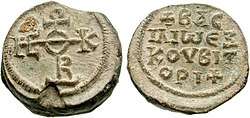
After a lapse towards the end of the 7th century and the first half of the 8th century, the Excubitors reappear in historical sources, under a new commander, the Domestic of the Excubitors (δομέστικος τῶν ἐξκουβίτων, domestikos tōn exkoubitōn) and in a new capacity, as one of the imperial tagmata, the elite professional central army established by Constantine V (r. 741–775).[8][16] As one of the tagmata, the Excubitors were no longer a palace guard, but a unit actively engaged in military campaigns. At the same time, the tagmata represented a counterbalance to the thematic armies of the provinces and constituted a powerful tool in implementing the iconoclastic policies pursued by Constantine V.[17] Nevertheless, the possibly first commander of the tagma, Strategios Podopagouros, was among the leaders of a failed plot against Constantine V's life in 765, and was executed after its discovery.[18] By the 780s, however, following years of imperial favour and military victories under Constantine V and his son Leo IV the Khazar (r. 775–780), the tagmata had become firm adherents to the iconoclast cause.[17] Within less than two months of Leo V's death in 780, Empress-regent Irene of Athens had to foil an attempt spearheaded by the Domestic of the Excubitors to place Constantine V's exiled second son Nikephoros on the throne,[19] and in 786 Irene forcibly disarmed them and exiled some 1,500 tagmatic soldiers due to their resistance to the restoration of the icons.[20][21]
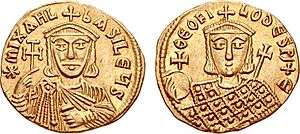
The Excubitors participated in the disastrous Pliska campaign in 811, when the Byzantine army was routed by Tsar Krum of Bulgaria; the Domestic of the Excubitors fell in the field along with the other senior Byzantine generals, including Emperor Nikephoros I himself (r. 802–811).[22] The most prominent Domestic of the Excubitors of the period was Michael II the Amorian (r. 820–829), whose supporters overthrew Emperor Leo V the Armenian (r. 813–820) and raised him to the throne.[23] The regiment also fought at the battles of Boulgarophygon in 896 and Acheloos in 917, both heavy defeats against the Bulgarians.[24] In the expedition against the Emirate of Crete in 949, the regiment participated with over 700 men.[24] In 958, the Excubitors participated in the repulsion of a Magyar raid.[24]
The Excubitors took part in the failed Azaz campaign of 1030, where they were ambushed and dispersed by the Mirdasids, while their commander, the patrikios Leo Choirosphaktes, was taken captive.[25] As with most of the tagmata, the regiment of the Excubitors did not survive the great upheavals of the later 11th century, when foreign invasion and constant civil wars destroyed much of the Byzantine army. The last mention of the Excubitors occurs in Anna Komnene's Alexiad, where they are recorded as participating at the Battle of Dyrrhachium against the Italo-Normans in 1081, under the command of Constantine Opos.[26][27][28]
Structure
| Byzantine army |
|---|
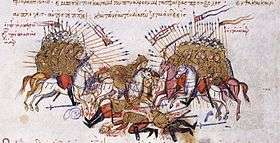 |
| This article is part of the series on the military of the Byzantine Empire, 330–1453 AD |
| Structural history |
|
|
| Campaign history |
| Lists of wars, revolts and civil wars, and battles |
| Strategy and tactics |
|
The internal structure of the original excubitores regiment is unknown, other than that it was a cavalry unit, and that it had officers called scribones. The historian Warren Treadgold speculates that they fulfilled a role similar to the regular cavalry decurions, commanding troops of 30 men each,[6] but John B. Bury suggested that the scribones, though associated with the excubitores, were a separate corps.[29]
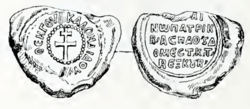
In its later incarnation as a tagma, the regiment (often called collectively τὸ ἐξκούβιτον, to exkoubiton or τὰ ἐξκούβιτα, ta exkoubita) was structured along standardized lines followed by the other tagmata, with a few variations.[30][31] The regimental commander, the Domestic of the Excubitors, (often also shortened to "the Excubitor", ὁ ἐξκουβίτωρ/ἐξκούβιτος) is well attested in the various lists of offices in the 9th–10th centuries, where his post is also held in tandem with that of the chief (dēmarchos) of the racing faction (dēmos) of the Greens.[32] The Domestics were originally of strikingly low court rank (mere spatharioi), but they gradually rose to importance: while in the Taktikon Uspensky of c. 842 the Domestic of the Excubitors came behind all the thematic commanders (stratēgoi) in order of precedence, in the Klētorologion of 899, the Domestic is shown as superior to the stratēgoi of the European themes and even to the Eparch of Constantinople. At the same time, the court dignities they held rose to those of prōtospatharios and even patrikios.[8][31]
The Escorial Taktikon, written c. 971/75, records the existence of a "Domestic of the Excubitors of the East" (δομέστικος τῶν ἐξκουβίτων τῆς ἀνατολῆς), and a "Domestic of the Excubitors of the West" (δομέστικος τῶν ἐξκουβίτων τῆς δύσεως), as well as a subaltern "Domestic of the Excubitors".[32] This has led to the suggestion that, probably under Romanos II (r. 959–963), the regiment, like the senior Scholae, was split in two units, one for the West and one for the East, each headed by a respective Domestic.[8][33] However, unlike the Scholae, these designations no longer appear after, and they may have been of brief existence.[32] The subaltern Domestic of the Excubitors may either by a copyist error, or, according to Vera von Falkenhausen, indicate a subordinate official in charge of Excubitors stationed in the provinces; indeed such provincial detachments are attested, albeit only for the theme of Longobardia in southern Italy and of Hellas in Greece.[34]
The Domestic was assisted by a topotērētēs (τοποτηρητής, lit. "placeholder", "lieutenant") and a chartoularios (χαρτουλάριος, "secretary").[31] Based on a reference from the hagiography of St. Joannicius, in 773 the regiment itself was divided into at least eighteen banda, probably each commanded by a skribōn (σκρίβων).[35][30] Each of them was further divided into sub-units headed by a drakonarios (δρακονάριος, deriving from the late Roman draconarius), and included three classes of standard-bearers who functioned as junior officers: the skeuophoroi (σκευοφόροι, "standard carriers"), signophoroi (σιγνοφόροι, i.e. signifers) and sinatores (σινάτορες, from the late Roman rank of senator).[36][37] There were also the usual messengers (μανδάτορες, mandatores) under a prōtomandatōr, some of whom were also termed legatarioi (λεγατάριοι).[36]
The size of the tagma of the Excubitors and its subdivisions can not be determined with certainty; as with the other tagmata, scholars are of differing opinions regarding its numerical strength. Drawing on the lists of officers and accounts of Arab geographers Ibn Khordadbeh and Qudamah, historian Warren Treadgold suggested an establishment strength of c. 4,000 men, which for the Scholae and the Excubitors rose to c. 6,000 with the division of the regiments in the mid-10th century.[38] Other scholars, most prominently John Haldon, have revised estimates to some 1,000 men for each tagma.[39] For security reasons, both the Scholae and the Excubitors were scattered in garrisons in Thrace and Bithynia rather than being stationed within Constantinople, making it harder for them to be used in mounting a coup.[40][41]
Known commanders of the Excubitors
| Name | Tenure | Notes | Refs |
|---|---|---|---|
| Counts of the Excubitors | |||
| Justin I | 515–518 | Count of the Excubitors under Emperor Anastasius I, before becoming emperor. From this post, he took part in the suppression of the rebellion of Vitalian, leading the imperial fleet against the rebel navy. | [42] |
| Priscus | 529 | A former secretary (notarius) of Justinian I, he became Count of the Excubitors but fell foul of Empress Theodora and was banished to Cyzicus and later a monastery. | [43] |
| Theodore | 535–536 | As Count of the Excubitors, he served with Solomon in North Africa, where he played a critical role in the Battle of Mount Bourgaon. He was murdered in Easter 536 in the mutiny led by Stotzas. | [44] |
| Marcellus | 541–552 | Count of the Excubitors, he is described by Procopius as an austere and incorruptible man, who took part in the discovery of the conspiracy of Artabanes. In 552, he was member of an embassy to Pope Vigilius. | [45] |
| Marinus | 561–562 | Count of the Excubitors, he was charged with suppressing racing faction violence in Constantinople, and in investigating the conspiracy to assassinate Emperor Justinian in November 562. | [46] |
| Tiberius II | 565–574 | A protégé of Justin II, he was appointed Count of the Excubitors during the reign of Justinian I already. In c. 570 he led the campaign against the Pannonian Avars around Sirmium and Thrace. When Justin II became insane, as the most influential member of the court he was named Caesar and de facto regent. | [47] |
| Maurice | 574?–582? | A notarius of Tiberius, he was probably appointed Count of the Excubitors as the latter's successor when Tiberius became Caesar. He likely held his post in tandem with the position of magister militum per Orientem against the Sasanian Empire, until he himself became Caesar in 582. By 577/8, he was also a patricius. | [48] |
| Philippicus | 582/584–603 | The husband of Maurice's sister Gordia, he was made Count of the Excubitors sometime early in Maurice's reign, and held it until he retired to a monastery in 603. He also served at the same time as magister militum' per Orientem against the Sasanians. | [49] |
| Priscus | 603?–612 | A distinguished general and patricius before being appointed as Count of the Excubitors shortly after Phocas came to power. In 607 he married Domentzia, daughter of Emperor Phocas, but conspired with Heraclius for the overthrow of Phocas. He led troops in Asia Minor against the Sasanians, but was dismissed and forced to retire as a monk by Heraclius in December 612. | [50] |
| Nicetas | 612–613 | Cousin of Heraclius, he participated in the overthrow of Phocas and was named a patricius. Named Count of the Excubitors in succession to Priscus, he led Byzantine troops against the Sasanians around Antioch, before going to Egypt as governor. | [51] |
| Valentinus | 6th/7th century | Patrikios and "Count of the Imperial Exkoubiton" (komēs tou basilikou exkoubitou), known only from his seal of office. | [52] |
| Valentinus | 641 | An Armenian aristocrat, he enforced the coronation of Constans II as co-emperor alongside Heraklonas, and was given the position of Count of the Excubitors. From this post, he led campaigns against the Arabs, and may have been responsible for the overthrow of Heraklonas and his mother, Empress-regent Martina. Possibly identical to the previous. | [53] |
| Stephen | 7th century | "Count of the Divine Exkoubiton" (komēs tou theiou exkoubitou), known only from his seal of office. | [54] |
| Domestics of the Excubitors | |||
| Paul | early 8th century | Patrikios, magistros, and Domestic of the Excubitors, grandfather of Patriarch Tarasios of Constantinople. | [55] |
| Strategios Podopagouros | 765 | A spatharios (in one text variant patrikios) and Domestic of the Excubitors (domestikos tōn ekskoubitōn [sic]), executed by Constantine V during his purge of iconophiles in 765. | [56][57][58] |
| Constantine | 780 | Son of a certain Vikarios. A spatharios and Domestic of the Excubitors (domestikos tōn ekskoubitorōn [sic]), he participated in a conspiracy against Empress-regent Irene of Athens in favor of the Caesar Nikephoros, and finally was arrested and imprisoned in a monastery. | [56][59][60] |
| Niketas | 750/800 | Basilikos prōtospatharios and Domestic of the Excubitors, known only from his seal of office. | [61][62][63] |
| Arsaber | 750/850 | Basilikos prōtospatharios and "Domestic of the Exkoubiton" (domestikos tou exkoubitou), known only from his seal of office. | [61][62] |
| Anonymous | 811 | "Domestic of the Exkoubiton" (domestikos tou ekskoubitou [sic]), he was killed at the Battle of Pliska. | [64] |
| Michael II | 813–? | The future emperor Michael II was appointed to the post of exkoubitos by Leo V in 813, and held it for a number of years. | [56][65] |
| Anonymous | 829/842 | Exkoubitos and simultaneously dēmarchos of the racing faction of the Greens, under Emperor Theophilos. | [66] |
| Constantine | c. 842 | [66] | |
| Leo | 869 | Patrikios and Domestic of the Excubitors, he is recorded among the attendants at the 869 Church council in Constantinople. | [66][67] |
| Ashot | 896 | An Armenian nobleman, he was regimental commander (exarchōn) and fell at the Battle of Boulgarophygon in 896. | [66] |
| Paul | 9th century | Basilikos prōtospatharios and Domestic of the Excubitors, known only from his seal of office. | [61][62][68] |
| Sergios | 9th century | Patrikios, basilikos prōtospatharios and Domestic of the Excubitors, known only from his seal of office. | [61][62] |
| Symbatios | 850/900 | Patrikios, basilikos prōtospatharios and Domestic of the Excubitors, known only from his seal of office. Possibly to be identified with Symbatios the Armenian (fl. 860s). | [61][62][69] |
| Theophilos | 9th century | Basilikos prōtospatharios and Domestic of the Excubitors, known only from his seal of office. | [61][62] |
| Aetios | late 9th/early 10th century | Basilikos prōtospatharios and Domestic of the Excubitors, known only from his seal of office. Potentially identical with a namesake Domestic of the Scholae, or a Drungary of the Watch of the same name. | [70] |
| John Grapson | 917 | He commanded the regiment and was killed at the Battle of Acheloos in 917. His father Maroules had been Domestic of the tagma of the Hikanatoi. John Skylitzes describes him as a valiant and distinguished warrior. | [66][67][71] |
| Anonymous | 949 | Referred to simply as "the exkoubitor", he participated with over 700 men and his topotērētēs in the failed expedition to Crete in 949. | [72] |
| Pothos Argyros | c. 958/9 | He is mentioned as being a patrikios and Domestic of the Excubitors when he defeated a Magyar raid in the Balkans. Identified by some with a namesake Domestic of the Scholae c. 922. | [66][73] |
| Peter | 990 | Referred to as an excubitus, he was murdered in southern Italy. | [74] |
| Makrotheodoros | 997 | Referred to as an excubitus, he was murdered at Oria in southern Italy. | [74] |
| Theodore | 998 | Mentioned in a deed from southern Italy, possibly identical with the previous. | [74] |
| John (?) | 950/1050 | Basilikos prōtospatharios, epi tou Chrysotriklinou (uncertain) and Domestic of the Excubitors of the West, known only from his seal of office. | [75] |
| Nikolitzes Kekaumenos | turn of 10th/11th century | The grandfather of the military writer Kekaumenos, who records him as Domestic of the Excubitors of Hellas. | [74] |
| Leo Patianos | 1017 | An excubitus who was killed during the revolt of Melus of Bari in southern Italy. | [74] |
| Leo Choirosphaktes | 1030 | Commanded the Excubitors during Romanos III's failed campaign into northern Syria. | [74] |
| Constantine Opos | 1081 | Commanded the Excubitors during the Battle of Dyrrhachium against the Italo-Normans. | [76] |
| Martinos (possibly also Marianos or Adrianos) | 9th/11th century | Patrikios, basilikos prōtospatharios and "Domestic of the Imperial Excubitors" (domestikos tōn basilikōn exkoubitōn), known only from his seal of office. | [77] |
References
- Treadgold 1995, pp. 13–14.
- Treadgold 1997, p. 152.
- Cameron, Ward-Perkins & Whitby 2000, pp. 47, 291.
- Evans 1996, pp. 11–12, 41.
- Cameron, Ward-Perkins & Whitby 2000, p. 291.
- Treadgold 1995, p. 92.
- Haldon 1984, pp. 136–139.
- Kazhdan 1991, pp. 646–647.
- Bury 1911, p. 57.
- Evans 1996, pp. 11–13.
- Treadgold 1997, p. 218.
- Evans 1996, pp. 264, 267.
- Treadgold 1997, p. 227.
- Treadgold 1997, pp. 309–310.
- Kaegi 1981, p. 174.
- Haldon 1999, p. 78.
- Whittow 1996, p. 168.
- Treadgold 1997, pp. 363–364.
- Treadgold 1997, p. 417.
- Whittow 1996, pp. 168–170.
- Treadgold 1997, pp. 419–420.
- Treadgold 1997, pp. 428–429.
- Treadgold 1997, p. 433.
- Kühn 1991, p. 103.
- Wortley 2010, p. 359.
- Birkenmeier 2002, pp. 156–159.
- Haldon 1999, pp. 91–93.
- Treadgold 1995, p. 41.
- Bury 1911, p. 59.
- Kühn 1991, p. 93.
- Bury 1911, p. 58.
- Kühn 1991, p. 94.
- Treadgold 1997, p. 494.
- Kühn 1991, p. 95.
- Bury 1911, pp. 58–59.
- Bury 1911, pp. 59–60.
- Treadgold 1995, pp. 102, 104.
- Treadgold 1995, p. 103.
- Haldon 1999, p. 102.
- Treadgold 1997, p. 359.
- Kühn 1991, pp. 92, 93–94.
- Martindale 1980, pp. 649–650, 1295.
- Martindale 1992, pp. 1051, 1510.
- Martindale 1992, pp. 1248, 1510.
- Martindale 1992, pp. 815–816, 1510.
- Martindale 1992, pp. 831, 1510.
- Martindale 1992, pp. 1324–1325, 1510.
- Martindale 1992, pp. 856, 1510.
- Martindale 1992, pp. 1022, 1510.
- Martindale 1992, pp. 1052–1057, 1510.
- Martindale 1992, pp. 940–942, 1510.
- Martindale 1992, pp. 1353, 1510.
- Martindale 1992, pp. 1354–1355, 1510.
- Martindale 1992, pp. 1197, 1510.
- PmbZ, Sisinnios (#6755).
- Kühn 1991, p. 96.
- Haldon 1984, p. 355.
- PmbZ, Strategios Podopaguros (#7130).
- Haldon 1984, pp. 355–356.
- PmbZ, Konstantinos (#3826).
- Kühn 1991, p. 99.
- Haldon 1984, p. 356.
- PmbZ, Niketas (#35427).
- PmbZ, Anonymus (#11339).
- PmbZ, Michael II. (#4990/corr.).
- Kühn 1991, p. 97.
- Haldon 1984, p. 357.
- PmbZ, Paulos (#5863).
- PmbZ, Symbatios (#7170).
- PmbZ, Aëtios (#20144).
- PmbZ, Ioannes Grapson (#22915).
- PmbZ, Anonymus (#31259).
- PmbZ, Pothos Argyros (#26730).
- Kühn 1991, p. 98.
- PmbZ, Ioannes (#23288).
- Kühn 1991, pp. 98–99.
- Kühn 1991, p. 100.
Sources
- Bury, John Bagnell (1911). The Imperial Administrative System of the Ninth Century - With a Revised Text of the Kletorologion of Philotheos. London: Oxford University Press.CS1 maint: ref=harv (link)
- Birkenmeier, John W. (2002). The Development of the Komnenian Army: 1081–1180. Leiden: Brill Academic Publishers. ISBN 90-04-11710-5.CS1 maint: ref=harv (link)
- Cameron, Averil; Ward-Perkins, Bryan; Whitby, Michael (2000). The Cambridge Ancient History, Volume 14 - Late Antiquity: Empire and Successors, AD 425-600. Cambridge: Cambridge University Press. ISBN 0-521-32591-9.CS1 maint: ref=harv (link)
- Evans, James Allan Stewart (1996). The Age of Justinian: The Circumstances of Imperial Power. New York: Routledge. ISBN 0-415-02209-6.CS1 maint: ref=harv (link)
- Haldon, John F. (1984). Byzantine Praetorians. An Administrative, Institutional and Social Survey of the Opsikion and Tagmata, c. 580-900. Bonn: Dr. Rudolf Habelt GmbH. ISBN 3-7749-2004-4.CS1 maint: ref=harv (link)
- Haldon, John F. (1999). Warfare, State and Society in the Byzantine World, 565-1204. London: University College London Press (Taylor & Francis Group). ISBN 1-85728-495-X.CS1 maint: ref=harv (link)
- Kaegi, Walter Emil (1981). Byzantine Military Unrest, 471–843: An Interpretation. Amsterdam: Adolf M. Hakkert. ISBN 90-256-0902-3.CS1 maint: ref=harv (link)
- Kazhdan, Alexander (1991). "Domestikos ton exkoubiton". In Kazhdan, Alexander (ed.). The Oxford Dictionary of Byzantium. Oxford and New York: Oxford University Press. pp. 646–647. ISBN 0-19-504652-8.
- Kühn, Hans-Joachim (1991). Die byzantinische Armee im 10. und 11. Jahrhundert: Studien zur Organisation der Tagmata (in German). Vienna: Fassbaender Verlag. ISBN 3-9005-38-23-9.CS1 maint: ref=harv (link)
- Lilie, Ralph-Johannes; Ludwig, Claudia; Pratsch, Thomas; Zielke, Beate (2013). Prosopographie der mittelbyzantinischen Zeit Online. Berlin-Brandenburgische Akademie der Wissenschaften. Nach Vorarbeiten F. Winkelmanns erstellt (in German). Berlin and Boston: De Gruyter.
- Martindale, John R., ed. (1980). The Prosopography of the Later Roman Empire: Volume II, AD 395–527. Cambridge: Cambridge University Press. ISBN 0-521-20159-4.
- Martindale, John R., ed. (1992). The Prosopography of the Later Roman Empire: Volume III, AD 527–641. Cambridge: Cambridge University Press. ISBN 0-521-20160-8.
- Treadgold, Warren T. (1995). Byzantium and Its Army, 284–1081. Stanford, California: Stanford University Press. ISBN 0-8047-3163-2.CS1 maint: ref=harv (link)
- Treadgold, Warren (1997). A History of the Byzantine State and Society. Stanford, California: Stanford University Press. ISBN 0-8047-2630-2.
- Whittow, Mark (1996). The Making of Byzantium, 600–1025. Berkeley and Los Angeles, California: University of California Press. ISBN 0-520-20496-4.CS1 maint: ref=harv (link)
- Wortley, John, ed. (2010). John Skylitzes: A Synopsis of Byzantine History, 811-1057. Cambridge: Cambridge University Press. ISBN 978-0-521-76705-7.CS1 maint: ref=harv (link)
